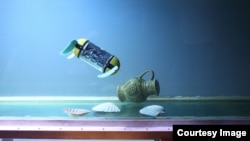Scientists have unveiled a robotic sea turtle designed to study shipwrecks humans can’t reach.
The robot, U-CAT, was developed at the Center for Biorobotics, Tallinn University of Technology in Estonia. It’s driven by four flippers, which make the robot highly maneuverable. It can swim forward and backward, up and down and turn on spot in all directions. This makes it ideal for exploring the tight nooks and crannies of shipwrecks.
The robot is also equipped with a camera for taking video of the wrecks, and because of the way it moves, it won’t kick up silt to cloud the water.
“Conventional underwater robots use propellers for locomotion. Fin propulsors of U-CAT can drive the robot in all directions without disturbing water and beating up silt from the bottom, which would decrease visibility inside the shipwreck”, says Taavi Salumäe, the designer of the U-CAT concept and researcher at the Tallinn University of Technology.
Scientists say biomimetic robots, robots that mimic animals or plants, are a rising trend in robotics.
Currently, the most common underwater robots are used in the oil and gas industry as well as in defense, but scientists say those kinds of robots are too big and expensive for diving inside wrecks.
Many reachable shipwrecks are usually explored by human divers, but that can be time consuming and dangerous.
Scientists say the robot, which will be on display at the Robot Safari in the London Science Museum from November 28 to December 1, will be tested in the Baltic and Mediterranean seas in the near future.
Here's a short video about the robot:
The robot, U-CAT, was developed at the Center for Biorobotics, Tallinn University of Technology in Estonia. It’s driven by four flippers, which make the robot highly maneuverable. It can swim forward and backward, up and down and turn on spot in all directions. This makes it ideal for exploring the tight nooks and crannies of shipwrecks.
The robot is also equipped with a camera for taking video of the wrecks, and because of the way it moves, it won’t kick up silt to cloud the water.
“Conventional underwater robots use propellers for locomotion. Fin propulsors of U-CAT can drive the robot in all directions without disturbing water and beating up silt from the bottom, which would decrease visibility inside the shipwreck”, says Taavi Salumäe, the designer of the U-CAT concept and researcher at the Tallinn University of Technology.
Scientists say biomimetic robots, robots that mimic animals or plants, are a rising trend in robotics.
Currently, the most common underwater robots are used in the oil and gas industry as well as in defense, but scientists say those kinds of robots are too big and expensive for diving inside wrecks.
Many reachable shipwrecks are usually explored by human divers, but that can be time consuming and dangerous.
Scientists say the robot, which will be on display at the Robot Safari in the London Science Museum from November 28 to December 1, will be tested in the Baltic and Mediterranean seas in the near future.
Here's a short video about the robot:









